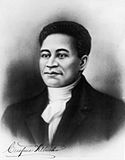Crispus Attucks
| Crispus Attucks | |
 Crispus Attucks | |
| Född | Okänt datum 1723 |
|---|---|
| Död | 5 mars 1770 (47 år) |
| Känd för | Den första martyren i det amerikanska frihetskriget |
Crispus Attucks, född 1723?, död 5 mars 1770 i Boston var i den första gruppen av fem personer som dödades i Bostonmassakern i Boston, Massachusetts.[1] Attucks anses allmänt vara det första amerikanska offret i det amerikanska frihetskriget
Bortsett från när och hur han dog, är inte mycket säkert känt om Attucks. Han kan ha varit en förrymd slav eller en fri man som arbetade till sjöss eller i hamnen. De flesta är överens om att han var Wampanoag och av afrikanskt ursprung. Attucks far kan ha varit Prince Yonger, en afrikansk-född slav och hans mor kan ha varit Nanny Peterattucks, tillhörande USA:s ursprungsbefolkning.[2]
Attucks blev en ikon inom antislaveri-rörelsen i mitten av 1800-talet.[3] På 1850-talet, i takt med att rörelsen mot slaveri växte i Boston, hyllades Attucks som en afroamerikansk hjälte.[4]
Martin Luther King skriver om Crispus Attucks i inledningen till Why We Can’t Wait (1964) som ett exempel på en man vars bidrag till historien förbisetts av den vita historieskrivningen.[5]
I Marvels tv-serie Luke Cage beskrivs Crispus Attucks som en amerikansk hjälte.[6]
Referenser
- ^ ”Boston Massacre Historical Society - Crispus Attucks”. http://www.bostonmassacre.net/players/crispus-attucks.htm. Läst 29 december 2016.
- ^ ”Crispus Attucks Biography”. www.biography.com. http://www.biography.com/people/crispus-attucks-9191864. Läst 29 december 2016.
- ^ ”Crispus Attucks, den första att falla.”. Uppgång och fall. 24 juni 2015. Arkiverad från originalet den 20 februari 2017. https://web.archive.org/web/20170220020438/https://uppgangochfall.wordpress.com/2015/06/24/crispus-attucks-den-forsta-att-falla/. Läst 19 februari 2017.
- ^ Margot Minardi (2007). The Inevitable Negro: Making Slavery History in Massachusetts, 1770–1863. Harvard University: PhD Dissertation. https://books.google.se/books/about/The_Inevitable_Negro_Making_Slavery_Hist.html?id=N8aUQwAACAAJ&redir_esc=y. Läst 30 december 2016
- ^ ”Crispus Attucks | Who Was Crispus Attucks?”. crispusattucks.org. Arkiverad från originalet den 30 december 2016. https://web.archive.org/web/20161230085846/http://crispusattucks.org/about/who-was-crispus-attucks. Läst 29 december 2016.
- ^ Jeremy Fuster (1 oktober 2016). ”‘Luke Cage': The True Story Behind Luke’s Hero, Crispus Attucks” (på amerikansk engelska). The Wrap. http://www.thewrap.com/luke-cage-the-true-story-behind-lukes-hero-crispus-attucks/. Läst 29 december 2016.
Media som används på denna webbplats
Public domain illustration.
Source information is necessary so we can verify the image is contemporaneous (which would make it ) Superm401 - Talk 01:03, 2 November 2007 (UTC)
Public domain portrait of Attucks, artist unknown. Image from w:en:Bridgewater State College archive in w:en:Bridgewater, Massachusetts.
If the source is unknown, we can't verify that it's PD. We need to show it was published before 1923, or that the artist died 70+ years ago. Superm401 - Talk 19:12, 2 November 2007 (UTC)
- According to w:en:Getty Images ([1], but this link may expire), the image was published on w:en:2 January, w:en:1754. It was published before 1923, and the author died before 1907, so the image is clearly . Superm401 - Talk 19:39, 2 November 2007 (UTC)
I added a better version of the image, from w:en:Encyclopedia Brittanica/Getty. Superm401 - Talk 20:02, 2 November 2007 (UTC)
- Getty Images' claim of a 1754 publication date for the image is improbable. It's not likely that an obscure 18th century "mulatto" runaway slave would have had a professional portrait done 16 years before the event that made him a legend. My guess is that the date given is a typo, and that "1854" was intended. That would be more believable because Attucks became a symbol during the Abolitionist movement at that time. (Uncle Tom's Cabin was published in 1852.) If so, the image is still clearly public domain, although not a genuine portrait made during Attucks's lifetime. —Kevin Myers 18:49, 17 November 2007 (UTC)
- You're right. That doesn't make sense. Nevertheless, if it was made 1854, it's still . Superm401 - Talk 02:18, 30 November 2007 (UTC)
